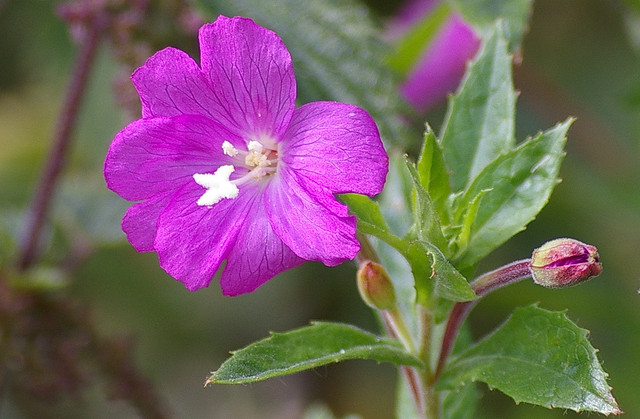Hairy Willow Herb
Daniel Kelly | Fondriest Environmental
Originally hailing from Eurasia and North Africa, the Hairy Willow-Herb now inhabits parts of Australia, Canada and the United States. The purple bloomer was largely planted as an ornamental flower in the early 1800s, but soon became a prolific garden weed.
It is believed to have made landfall in the U.S. through ship ballast water and was first spotted in Rhode Island. From there, it has taken up residence in parts of the northeastern U.S. and Canada, as well as the Great Lakes region.
Hairy Willow-Herb is an attractive plant with four rose-purple petals. It grows anywhere from 3 to 6 feet in height. Its flowers are just shy of an inch in width and Hairy Willow-Herb stems are covered in hairs. Capable of growing in dense patches, the semi-aquatic plant can crowd out native species with ease.
This dense growth is helped by its reproduction mechanisms, including rhizomes and seeds that adapt to conditions surrounding them. Hairy Willow-Herb plants are known to send out subterranean stems to take hold of Earth nearby. They are also capable of developing aerenchymal tissue that lets them grow while submerged in water.
Prevent Its Spread
The most important step to keeping Hairy Willow-Herb in check is to make sure fragments of the plant aren’t transported from one area to another. This can be accomplished by inspecting boat hulls, motors and safety equipment after exiting one waterway and before entering others.
Once the flowering plant has established a foothold, it can be dug up, bagged and disposed of in the trash. This treatment is most effective on small infestations, where as many of the plant’s rhizomes and root fragments can be removed as possible. After an area has been cleared, it should be checked for regrowth within a few months. Hairy Willow-Herb can also be controlled with herbicides. Those approved for use in aquatic environments work the most efficiently.
Sources:
- https://www.nwcb.wa.gov/weeds/hairy-willow-herb
- http://www.kingcounty.gov/environment/animalsAndPlants/noxious-weeds/weed-identification/hairy-willowherb.aspx
- http://www.ecy.wa.gov/programs/wq/plants/weeds/willowherb.html
- http://www.dcnr.state.pa.us/cs/groups/public/documents/document/dcnr_20027199.pdf
- https://www.eddmaps.org/distribution/uscounty.cfm?sub=5585
- http://plants.usda.gov/core/profile?symbol=EPHI











